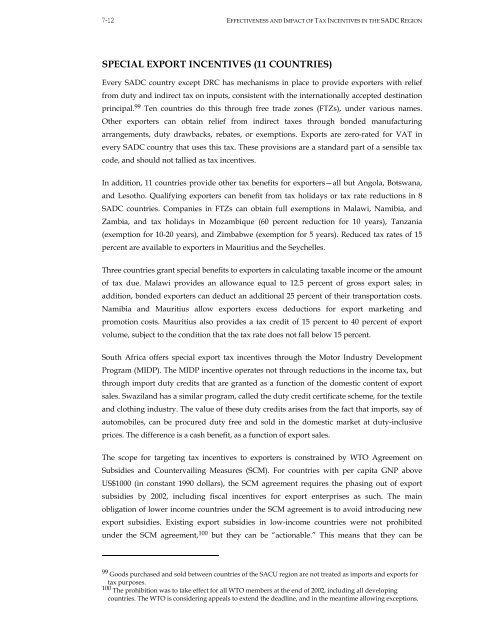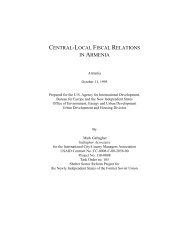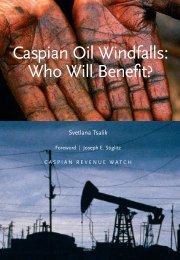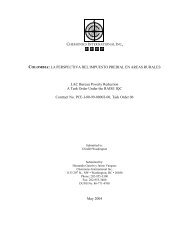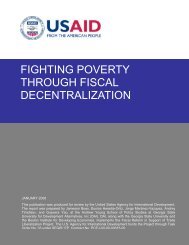Effectiveness and Economic Impact of Tax Incentives in the SADC ...
Effectiveness and Economic Impact of Tax Incentives in the SADC ...
Effectiveness and Economic Impact of Tax Incentives in the SADC ...
Create successful ePaper yourself
Turn your PDF publications into a flip-book with our unique Google optimized e-Paper software.
7-12 EFFECTIVENESS AND IMPACT OF TAX INCENTIVES IN THE <strong>SADC</strong> REGION<br />
SPECIAL EXPORT INCENTIVES (11 COUNTRIES)<br />
Every <strong>SADC</strong> country except DRC has mechanisms <strong>in</strong> place to provide exporters with relief<br />
from duty <strong>and</strong> <strong>in</strong>direct tax on <strong>in</strong>puts, consistent with <strong>the</strong> <strong>in</strong>ternationally accepted dest<strong>in</strong>ation<br />
pr<strong>in</strong>cipal. 99 Ten countries do this through free trade zones (FTZs), under various names.<br />
O<strong>the</strong>r exporters can obta<strong>in</strong> relief from <strong>in</strong>direct taxes through bonded manufactur<strong>in</strong>g<br />
arrangements, duty drawbacks, rebates, or exemptions. Exports are zero-rated for VAT <strong>in</strong><br />
every <strong>SADC</strong> country that uses this tax. These provisions are a st<strong>and</strong>ard part <strong>of</strong> a sensible tax<br />
code, <strong>and</strong> should not tallied as tax <strong>in</strong>centives.<br />
In addition, 11 countries provide o<strong>the</strong>r tax benefits for exporters—all but Angola, Botswana,<br />
<strong>and</strong> Lesotho. Qualify<strong>in</strong>g exporters can benefit from tax holidays or tax rate reductions <strong>in</strong> 8<br />
<strong>SADC</strong> countries. Companies <strong>in</strong> FTZs can obta<strong>in</strong> full exemptions <strong>in</strong> Malawi, Namibia, <strong>and</strong><br />
Zambia, <strong>and</strong> tax holidays <strong>in</strong> Mozambique (60 percent reduction for 10 years), Tanzania<br />
(exemption for 10-20 years), <strong>and</strong> Zimbabwe (exemption for 5 years). Reduced tax rates <strong>of</strong> 15<br />
percent are available to exporters <strong>in</strong> Mauritius <strong>and</strong> <strong>the</strong> Seychelles.<br />
Three countries grant special benefits to exporters <strong>in</strong> calculat<strong>in</strong>g taxable <strong>in</strong>come or <strong>the</strong> amount<br />
<strong>of</strong> tax due. Malawi provides an allowance equal to 12.5 percent <strong>of</strong> gross export sales; <strong>in</strong><br />
addition, bonded exporters can deduct an additional 25 percent <strong>of</strong> <strong>the</strong>ir transportation costs.<br />
Namibia <strong>and</strong> Mauritius allow exporters excess deductions for export market<strong>in</strong>g <strong>and</strong><br />
promotion costs. Mauritius also provides a tax credit <strong>of</strong> 15 percent to 40 percent <strong>of</strong> export<br />
volume, subject to <strong>the</strong> condition that <strong>the</strong> tax rate does not fall below 15 percent.<br />
South Africa <strong>of</strong>fers special export tax <strong>in</strong>centives through <strong>the</strong> Motor Industry Development<br />
Program (MIDP). The MIDP <strong>in</strong>centive operates not through reductions <strong>in</strong> <strong>the</strong> <strong>in</strong>come tax, but<br />
through import duty credits that are granted as a function <strong>of</strong> <strong>the</strong> domestic content <strong>of</strong> export<br />
sales. Swazil<strong>and</strong> has a similar program, called <strong>the</strong> duty credit certificate scheme, for <strong>the</strong> textile<br />
<strong>and</strong> cloth<strong>in</strong>g <strong>in</strong>dustry. The value <strong>of</strong> <strong>the</strong>se duty credits arises from <strong>the</strong> fact that imports, say <strong>of</strong><br />
automobiles, can be procured duty free <strong>and</strong> sold <strong>in</strong> <strong>the</strong> domestic market at duty-<strong>in</strong>clusive<br />
prices. The difference is a cash benefit, as a function <strong>of</strong> export sales.<br />
The scope for target<strong>in</strong>g tax <strong>in</strong>centives to exporters is constra<strong>in</strong>ed by WTO Agreement on<br />
Subsidies <strong>and</strong> Countervail<strong>in</strong>g Measures (SCM). For countries with per capita GNP above<br />
US$1000 (<strong>in</strong> constant 1990 dollars), <strong>the</strong> SCM agreement requires <strong>the</strong> phas<strong>in</strong>g out <strong>of</strong> export<br />
subsidies by 2002, <strong>in</strong>clud<strong>in</strong>g fiscal <strong>in</strong>centives for export enterprises as such. The ma<strong>in</strong><br />
obligation <strong>of</strong> lower <strong>in</strong>come countries under <strong>the</strong> SCM agreement is to avoid <strong>in</strong>troduc<strong>in</strong>g new<br />
export subsidies. Exist<strong>in</strong>g export subsidies <strong>in</strong> low-<strong>in</strong>come countries were not prohibited<br />
under <strong>the</strong> SCM agreement, 100 but <strong>the</strong>y can be “actionable.” This means that <strong>the</strong>y can be<br />
99 Goods purchased <strong>and</strong> sold between countries <strong>of</strong> <strong>the</strong> SACU region are not treated as imports <strong>and</strong> exports for<br />
tax purposes.<br />
100 The prohibition was to take effect for all WTO members at <strong>the</strong> end <strong>of</strong> 2002, <strong>in</strong>clud<strong>in</strong>g all develop<strong>in</strong>g<br />
countries. The WTO is consider<strong>in</strong>g appeals to extend <strong>the</strong> deadl<strong>in</strong>e, <strong>and</strong> <strong>in</strong> <strong>the</strong> meantime allow<strong>in</strong>g exceptions.


